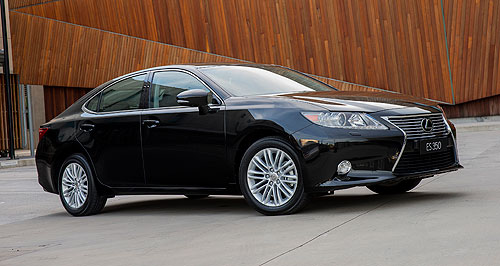Driven: Lexus ES returns, this time with hybrid
BY TIM NICHOLSON | 6th Nov 2013

Australia missed out on the fifth-generation ES as it was built only in left-hand drive, but after lobbying from Lexus Australia for right-hand production, the Japanese parent company committed to launching the sixth-generation with the steering wheel on the right side too.
As previously reported, the front-wheel drive ES range kicks off with the petrol-electric hybrid ES300h Luxury from $63,000 plus on-road costs, while the cheapest non-hybrid is the ES350 Luxury starting at $65,000.
The Sports Luxury ES300h is priced at $72,000, while the flagship ES350 Sports Luxury tops the range at $74,000.
Lexus says the then-new fourth-generation ES300 had a recommended retail price of $84,900 when it launched in 2001, marking a $21,900 drop for the 2013 version.
By the time Lexus officially discontinued the ES in Australia in 2006, it carried a price of $76,500, making it $13,500 more expensive than today's most affordable model.
The pricing of the ES range places it somewhere between the 3 Series-rivalling Lexus IS ($55,900-$84,000) and the similarly proportioned GS ($77,045-$121,900). The company says it is positioned in line with the BMW 3 Series, Audi A4 and Mercedes-Benz C-Class, but is larger than all of those vehicles.
During its previous Australian life-span from 1992 to 2006, Lexus sold 7000 ES models and the luxury brand's local arm claims 70 per cent of owners repurchased an ES when they replaced their exisiting model.
Lexus Australia chief executive Sean Hanley said there had been solid interest in the new-generation ES since the company announced its return to the local market earlier this year.
“The all-new ES presents Lexus with a fantastic opportunity to re-engage with existing loyal Lexus customers while tempting many vehicle purchasers – some of whom will be first-time luxury buyers,” he said.
“After a seven-year hiatus, we are pleased to offer ES to Australian customers and our strong pre-orders support our decision to bring ES back.”The ES300h petrol-electric hybrid is powered by a 118kW/213Nm 2.5-litre petrol engine and a 105kW/270Nm electric drive motor producing a maximum combined output of 151kW, matched with a continuously variable transmission. The petrol-electric drivetrain pushes the 1685kg ES300h from a standing start to 100km/h in 8.5 seconds.
The 204kW/346Nm 3.5-litre VVT-i V6 petrol unit in the ES350, mated to a standard six-speed automatic transmission is slightly quicker, with a 7.4-second 0-100km/h sprint time.
Fuel economy is better in the hybrid model, with the ES300h sipping 5.5 litres per 100 kilometres compared with the ES350’s 9.5 L/100km on the combined cycle.
Mr Hanley said the new ES was the first hybrid to open pricing for a Lexus model.
“The decision to lead ES Line pricing with hybrid is a result of higher consumer demand and the commercialisation of hybrid technology,” he said.
“More than 30 per cent of Lexus customers locally choose hybrid as their preferred drivetrain and we believe ES will grow that proportion as we edge ever closer to our goal of 50 per cent hybrid,” he said.
With its own unique platform, the ES measures in at 4900mm long and 1820mm wide with a 2820mm wheelbase, making it slightly longer, narrower and with a shorter wheelbase than its mid-size GS sibling.
The ES is 45mm longer than the fourth-gen version and lighter than fifth-generation model, and Lexus says it has done significant engineering work to reduce noise, vibration and harshness.
Further developments include improved rigidity, new dual-link rear suspension for better straight-line stability, a new electric power steering system and a drive mode selection (Eco, Sport and Normal) that alters steering, throttle and climate-control systems to suit the user.
The cabin offers a dashboard split between a display zone and an operations zone, hand-crafted finish on the dash, piped LED ambient lighting soft-touch finishes, leather-accented trims and three interior colours – black, light grey and ivory.
Lexus claims segment-leading rear legroom, thanks to a long wheelbase and a special front seat design, and even suggests that at 1015mm it is bigger than the Mercedes-Benz S-Class. Boot capacity is 490 litres for the ES350 and 425 litres for the ES300h, and both variants carry a full-size spare tyre.
Standard comfort features across the ES range include dual-zone climate control, Lexus Remote Touch, a moon roof, heated front seats, DAB digital radio with Bluetooth audio and phone connectivity, power front seats, a power rear sunshade and 17-inch alloy wheels.
Sports Luxury models add wood-grain trim, 8.0-inch colour display, sat-nav, a Mark Levinson premium sound system with 15 speakers and rear outboard seat heaters.
Lexus says its climate control system is even good for your skin. It features something called 'Nanoe' technology that uses microscopic ions with 1000 times the water content, allowing for a system that is said to be gentler on the occupant's skin that other air-conditioning units.
Safety wise, the ES features 10 airbags including full-length curtain airbags, reversing camera, rear parking sensors, a blind spot monitor, tyre-pressure warning system and the 'Pre-Collision' safety system that includes adaptive cruise control.
This feature is available as a $3000 option on ES300h but is standard on all other variants.
Lexus ES pricing*
| 300h Luxury | $63,000 |
| 300h Sports Luxury | $72,000 |
| 350 Luxury | $65,000 |
| 350 Sports Luxury | $74,000 |